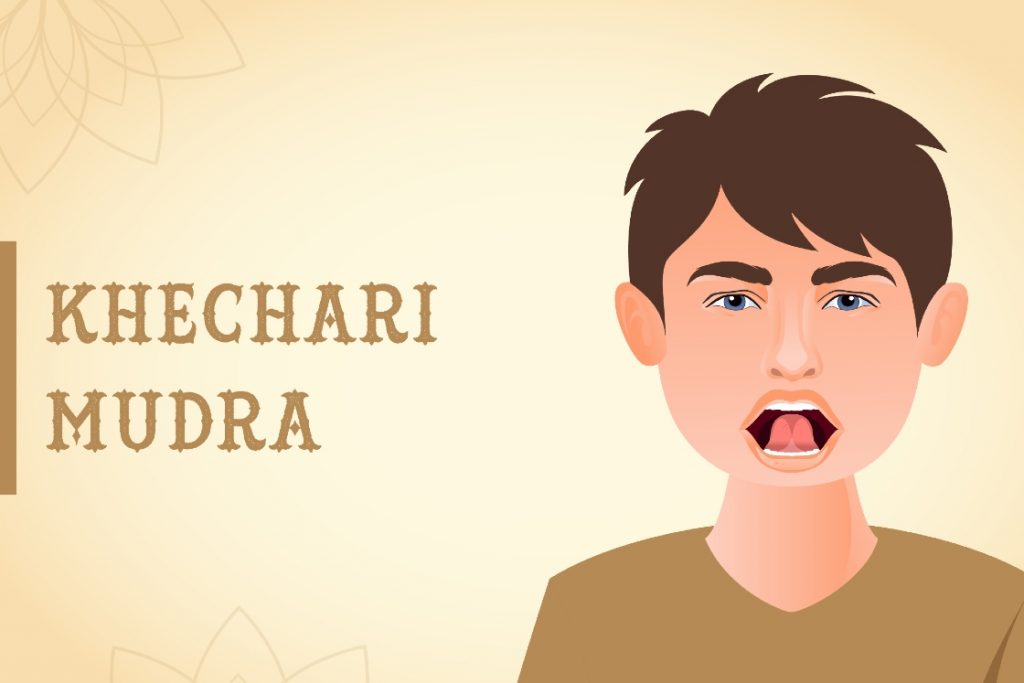
Yoga, an ancient practice originating from India, encompasses various disciplines that aim to unite the body, mind, and spirit. Among these diverse forms, Khechari Mudra stands out as a profound yet esoteric technique. It is believed to unlock spiritual realms and enhance physical well-being through the manipulation of the tongue.
In Hatha Yoga Pradipika, yogis describe Khechari Mudra as a practice through which they can taste the bliss of nectar, symbolizing profound spiritual experience and inner transformation.
What is khechari mudra?
Khechari mudra is a type of Mana Mudra (mudras involves head) in which the tongue is rolled up & back and draw deep to the nasopharynx (nasal cavity). Then tongue is locked back there into the nasal cavity, behind the palate (so it’s called ‘tongue lock’).
Because khechari mudra stimulates the master gland pituitary (situated behind the nasal cavity), it’s also king of all mudras. In spiritual language, the pituitary gland is the synonym of the third eye that is said to bring yogi to the higher stage of consciousness.
To do this mudra, a practitioner should first practice rolling of tongue.
- With consistent practice, the tongue becomes flexible and it can be elongated to the pit of the throat.
- This is the point which on stimulation begins flowing the Amrita – ‘nectar of Immortality’.
Khechari mudra is also a technique of kriya yoga where talavya kriya (tongue-palate exercise) practiced prior to it. In Talavaya Kriya, the tongue is stretched in & out repeatedly so that it becomes flexible and long enough to do Khechari mudra.
The easy version of Khechari Mudra is called ‘Nabho mudra‘ when a practitioner is not able to touch uvula (lower part of nasal cavity). In this mudra, the tongue is pressed against the soft palate only. It’s also called ‘small khechari mudra’.
Khechari mudra meaning
Khechari has two root words, Kha and Chara
- Kha means ‘Brahman‘ or ‘Space’ which is infinite
- Chara means ‘Obstacle free moving’ or ‘flying’
- Mudra means ‘a symbolic gesture’.
Khechari mudra means a symbolic gesture of moving freely in the infinite space of Brahman. How it’s so?
Because khecahri mudra lets the tongue to pierce to the top and stimulate the pituitary gland. When the secretion of this gland takes place, it makes practitioners feel the bliss of moving freely into the infinite space of brahman.
Here in this video kriya yoga master Swami Nityananda Giri has described and demonstrated the khechari mudra.
Preparation
To practice Khechari mudra, Hatha Yoga Pradipika mentioned frenum (skin below tongue that links it with gums) should be cut in order to increase the extension of the tongue (ONLY recommended under the guidance of an experienced teacher).
But it can be achieved without cutting frenum, as mentioned in Kriya Yoga & Raja Yoga. In order to prepare for Khechari mudra, it can be done;
- By exercising tongue in talavya kriya
- Doing Nabho Mudra – tongue to the soft palate, for the first few months.
- The tongue can be stretched like any other muscle. To prepare the tongue for khechari mudra, milking of the tongue is done for a few months before actual practice begins.
Khechari mudra steps & stages
- One should sit in a meditative pose and fix gaze to the center space between eyes i.e. Third eye chakra.
- Close your mouth, take a few deep breaths, and then do normal breathing.
(As a beginner you can keep your mouth open to be more aware of tongue movement.)
Khechari mudra stage 1 – soft palate to uvula
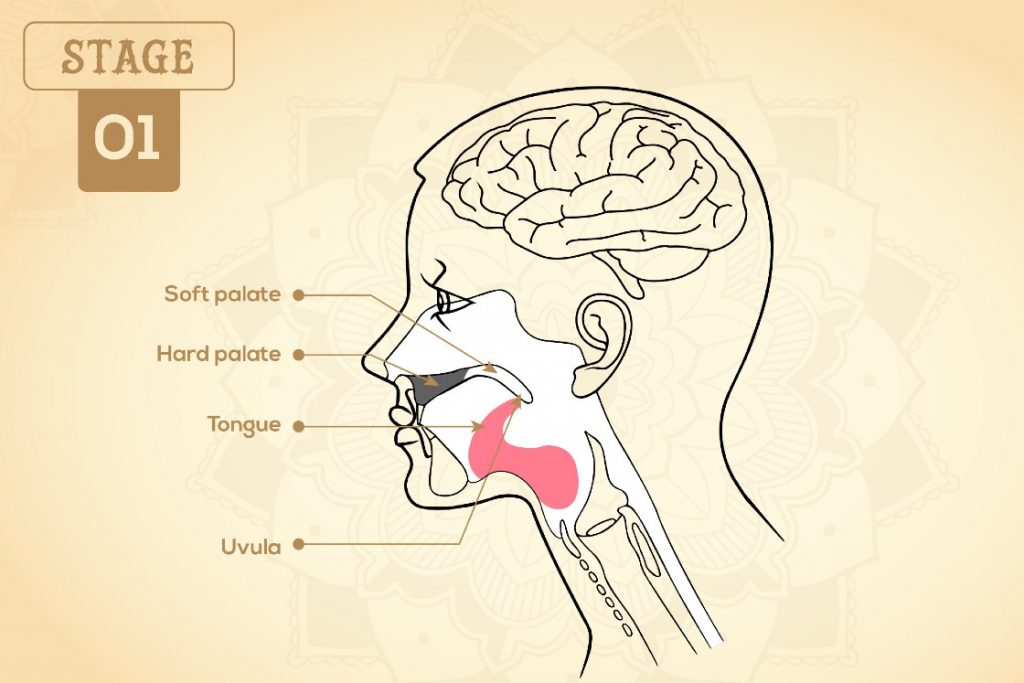
- To begin Khechari mudra, extend your tongue up and then roll it back to reach as far as you can. Initially, the tongue may barely reach to the hard palate. Do fake swallowing to slide tongue up to the soft palate. Do it 3-4 times until your tongue rests comfortably at the soft palate.
- Now try to slide your tongue further into the mouth. If you can’t do it by simple means, you can push the back of the tongue with your clean finger.
- Reach with your tongue at the bottom of your mouth where it touches the Uvula (a punching bag like structure in your mouth hanging over your tongue).
- Once you reach this far, do it 3-4 times to get your tongue comfortable up to this point.
Khechari mudra stage 2 – passing the uvula
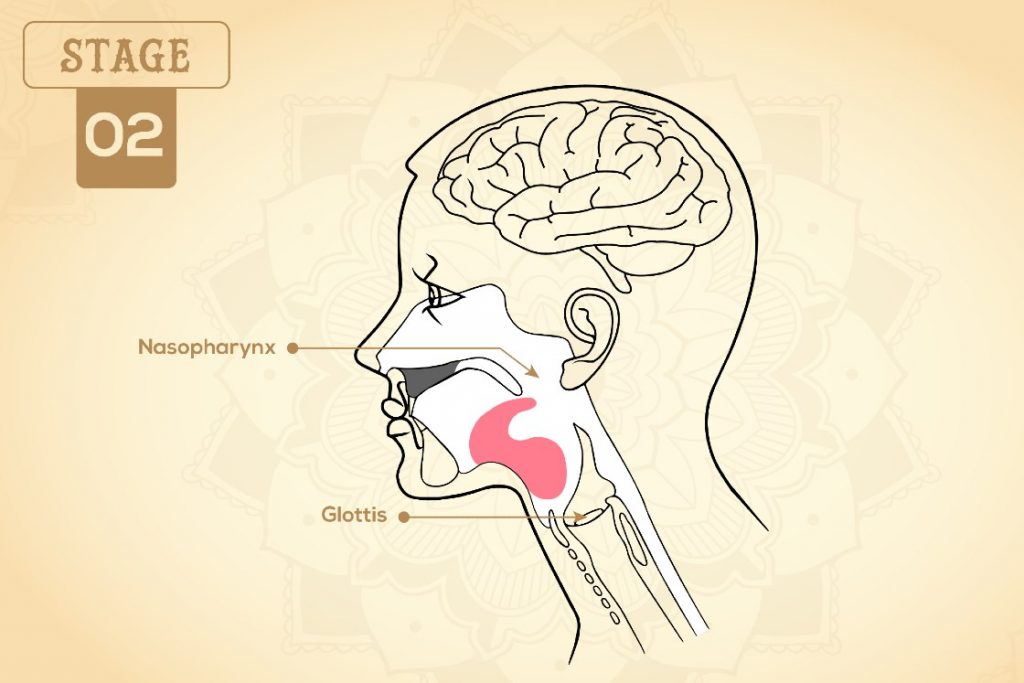
- Now as your tongue touching the uvula, open your glottis and mouth quickly to blow a bit of air inside the throat.
- This strong bust of air will push rolled tongue behind the uvula and your tongue will ready to enter into the nasopharynx.
Khechari mudra stage 3 – Slipping tongue Into the nasopharynx
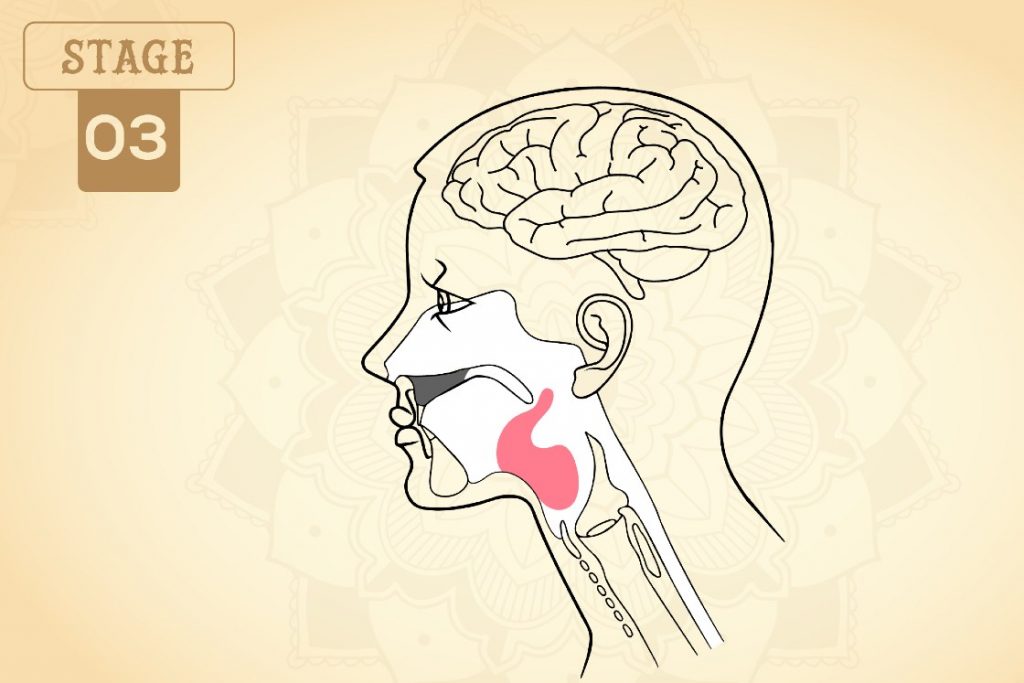
- Once tongue makes its way behind the uvula, now its turn to find a place behind uvula from where the tongue doesn’t come to its previous position. This part will come naturally, the tongue will begin slipping but at this moment there would be a strong urge of throwing out tongue.
- Keep breathing slowly, observe what’s happening inside your mouth. One just needs to come over this urge by observing the situation.
- Eventually, your tongue will start slipping into nasopharynx behind the soft palate. This will take tongue to the upmost where it touches a bony structure called the pituitary gland.
Khechari mudra stage 4 – pressing pituitary to secrete nectar
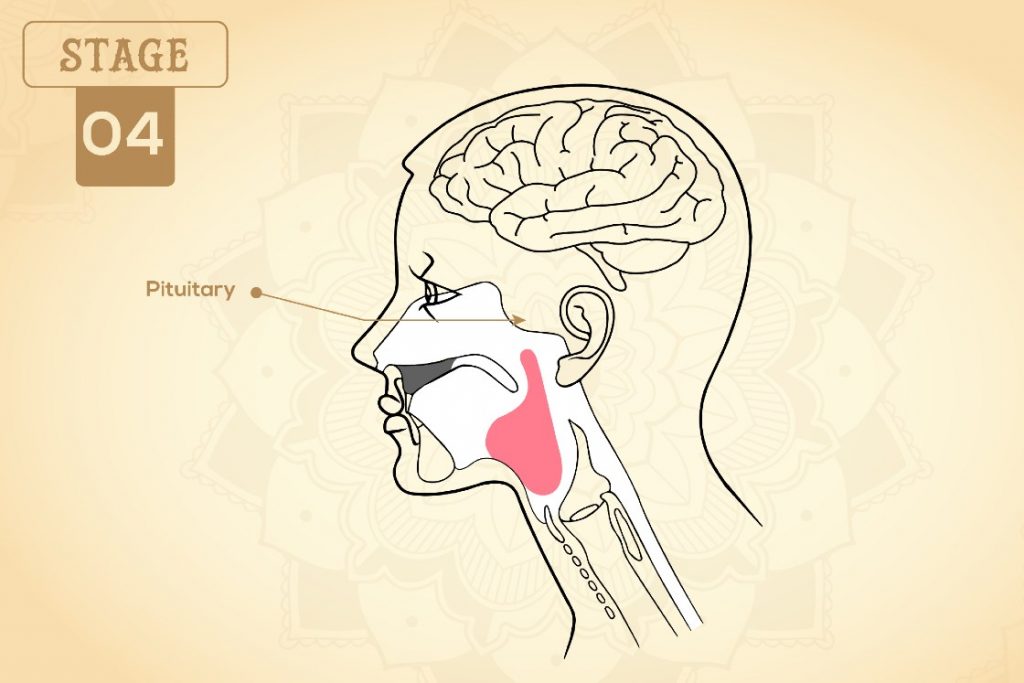
- Up to this point, the tongue has reached beyond the top of the pharynx. You will feel an emptiness in the mouth on reaching up to this point.
- Tongue touching at the topmost point here is nothing but space between your third-eye, where you asked to focus on at the beginning of this practice. Physiologically, this is the seat of the ‘Pituitary gland’, the master gland of the body.
- When the tongue pressed against this, it gets stimulated.
- Some fluid will start accumulating in your mouth but saliva wouldn’t be swallowed as long as your tongue remains up.
- Slowly, bring your tongue down to natural position and you will found the taste of saliva accumulated inside your mouth.
- In the beginning, the taste of it would be bitter, is a sign of detoxification of your bodily system. But with practice, you will realize the bitter taste becomes sweet like honey, strawberry, and butter taste. It’s called ‘Amrita – the bliss of nectar‘ in Hatha Yoga Pradipika.
Working of khechari mudra
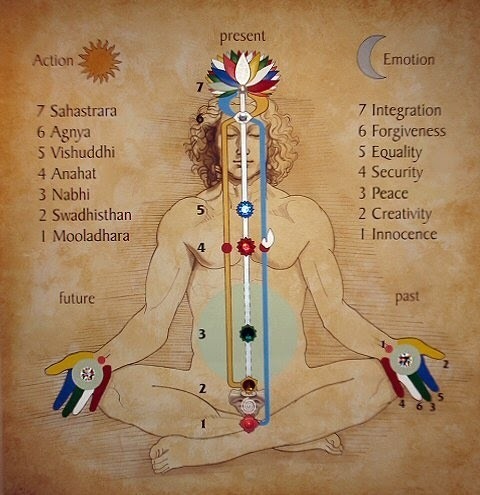
The throat in our body is the junction point between the first five chakras (associated with the five elements) and the last two chakras (beyond the earthly elements). Because of this junction, Prana flow at the throat level gets interrupted and our brain centers don’t get enough ‘Prana – vital energy’. Therefore, our minds distract often when we try to focus it on one thought or one place.
In khechari mudra, when the tongue is extended up to the pit of the throat, it creates a lock at this junction point. Hence, it’s also called tongue lock mudra. Now Prana can easily travel through this bypass to the higher chakras (Ajna and shahsarara chakra). In this way, Prana starts flowing freely and the mind becomes relaxed & focused.
Khechari mudra benefits
One who accomplishes this khechari mudra is neither troubled by diseases, nor death, lassitude, sleep, hunger, thirst, or unconsciousness.
Hatha Yoga Pradipika, 3.39
- This mudra opens up blocked salivary glands and prevents painful symptoms of salivary gland disorders
- As khecahri mudra stimulates the pituitary gland, It activates the parasympathetic nervous system (PNS). On PNS activation, your body conserves energy by slowing down the heart rate – low breath rate (5 to 8 breath/minute) and you feel relaxed.
- Tongue rolled inside is a symbol of restraining our senses to go outwards. Also, if we fixed the tongue in one place (like in this mudra), it’s very difficult to talk to yourself eventually, thoughts get reduced. This way, khechari mudra is very helpful to draw mind inwards that makes meditation much easier.
- The regular practice of khechari mudra removes symptoms of aging. It stimulates the pituitary gland that secretes growth hormone, also called anti-aging elixir.
- Khechari mudra with ujjayi breathing balances the secretion of the thyroid gland. Balanced secretion of the thyroid gland is very important to have a better metabolism, optimum body weight, growth, and development.
- Khechari mudra brings many spiritual powers like third-eye chakra awakening, precognition, and extrasensory perception.
- It’s a cleansing practice also that on the secretion of nectar detoxifies the body, clears the tongue gag, and prevents bad breath (halitosis).
- Khechari mudra meditation is an effective technique to be in a tranquil state of mind. This mudra locks the air inside the lungs and prevents exhalation in deep meditation, which doesn’t let our awareness to be scattered.
- It makes the tongue more sensitive to taste an individual element. Hence, panch tattva (5 elements) dominancy or deficiency can be addressed easily by mastering this mudra.
5 tastes relation to the 5 elements: sweet – earth, sour – air, salty – water, pungent – ether, bitter – fire.
Precautions
However, there are no side effects of khechari mudra but one can notice blood sticking to the tip tongue while managing the tongue to reach the end of the nasal cavity. There is nothing to fear in this, one should keep following precautions in mind;
- This mudra is not advised to do without any guidance from an expert teacher.
- A low protein diet should be taken while preparing for this mudra.
- Mastering stage 1 & 2 only itself can take around 6 to 7 months of practice, so it’s not advised to practice all stages the first day only. A beginner should practice stage 1 until it gets comfortable.
- Cutting of frenum is done at an early age and strictly advised to do under the guidance of Guru.
Final words
Khechari mudra is called ‘King of all mudras’ because of its capability to stimulate the master gland of the body. Even if you as a beginner isn’t able to do full khechari mudra, small khechari mudra (nabho mudra) brings many benefits at the physical level.
You can do this mudra anytime, but it’s highly recommended during the meditation sessions. So whenever you sit for meditation, hold your tongue against the soft palate and you will see, it becomes easy to control your thoughts, minimal thoughts.


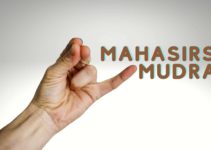


Hello, thank you very much for the wonderful article, I have been practicing Khechari Mudra for a long time and Khechari Mudra feels amazing….
A small problem, what is the reason for feeling cold. Please tell me in detail.🙏🕉️
Namaste Ratan 🙏🕉️
Thank you for your kind words—so glad to hear Khechari Mudra is bringing you beautiful experiences.
That cool sensation you’re feeling is actually quite natural. When the tongue touches the upper palate or goes deeper, it stimulates the vagus nerve and activates the parasympathetic nervous system, creating a calming, cooling effect in the body.
It can also gently influence the pineal and pituitary glands, leading to inner stillness and a subtle feeling of blissful “coolness” rather than physical cold.
So nothing to worry—it’s a sign your energy is shifting inward beautifully.
Stay steady on the path 🙏✨
— Ashish
Ami kivabe join karbo
It’s such an inspiring article. Thanks for sharing!
This has been interesting reading. It was only last night that I heard of this mudra from a friend who has been been practicing Kriya yoga for decades. I was able to get my tongue well into the nasal cavity at the first try and got scared and pulled it out. My personal yoga practice is very rusty and barely existent. How does one breath with the tongue well into the nasal cavity ? How long does one hold this ?
Thanks for a very detailed step by step approach. Very helpful. Your comments on Kechari mudra and Kriya Yoga Practice which also has several common elements.
Dear Ashish. Thank you for the valuable knowledge you share with us trough your interesting posts.
Do you think is there any risk if a beginner practises Nabho Mudra by himself? Some authors affirm that this mudra must be practiced only by the guidance of an expert or a master of Yoga
Nabho Mudra itself can be considered a preparatory step before one starts with khechari. It’s more like a learning practice; your focus is on lengthening the tongue and making it flexible to slip backwards so in the earlier stage one can practice by himself. Though when you think you become comfortable with the initial stage, you should definitely take the assistance of a teacher.
I have been practicing this Kechari Mudra for 9 months now (coincidence?) and here are my experiential notes from it:
1. Jolts in the body when I do it for a long time in the relaxing position 2. Pain in toes in the first month 3. My posture improved, Spine became more erect 4. Loss of chocolate cravings (I used to eat a bar of chocolate EVERY DAY) 5. 9V battery sensation on my tongue and inside the brain. 6. Right side of the brain gentle pain in the first 2 months and then right cheek + nervous tic there 7. Sinus disappeared for good. 8. Heat or cold indifference 9. Desire to be silent and practice Kechari more as it becomes SUPER Pleasant, it feels like a gentle orgasm in the whole body. 10. Body odor improvement. I smell better. 11. Lots of thirst in the beginning – drink a lot of water!!!! 12. Honey taste of saliva after a few months (in the beginning it was salty and then sour). 13. At the final stage of Kechari, when your tongue moves as high inside as possible – a little soft “pillow” appeared to lay the tongue there for a long time = this one was so weird for me and Shocked me big time (our body is a miracle) 14. Recently I have been getting super heavy and deep breathing without my control. Somehow Kechari required lots of Oxygen and Water! So do not panic if your body starts to breathe deep on its own. 15. Recently I have been getting this gentle pressure within the brain and on top of the head (almost like the 7th Crown Chakra opening ) – it feels very very good and pleasant. 16. A month ago I got gentle vibrations inside my chin area – lots of good energy flow there because the tongue connects the Hearth (Earth) and the Brain in the neck area where the chin is located. 17. Desire to sit more and concentrate on Crown of the Head (it might be a good indication that I am getting closer to the Meditation stage). 18. On August 21, before the full MOON on 22-8-2021=4-8-5 I had similar as in the spine orgasmic vibrations in my nipples
I know this was a lot, but I hope this inspires you and yours to practice this Kechari Mudra.
At this point, I think that Kundalini Snake or Serpent is our tongue. It supposed to rise up to touch the brain and uvula (that tissue that hangs down from the top should touch the base of the togue on the inside and both of those form – A STAR OF DAVID=Triangle up to the brain and triangle down to the Hearth/Earth) OMG!
Seems like you really have a wonderful experience Aliaksandr. I certainly haven’t gone through some of your mentioned experiences so far (like my tongue can’t comfortably stay for longer in the back of my throat) but I agree with consistent practice one would definitely be able to achieve this. Thanks for sharing your experience.
I am doing Khechari Mudra with deep meditation along with Brukuti
Salaiva taste i am feeling on my mouth this will be increase when the time of Hunger in my stomach
its wonderful experience in 15 days only.
Send me more mudra and yoga bhyasa
Lovely article. Currently we are engaged in translating “Dnyaneshwar’s Sanad” –
which is his Promise to all knowledge seekers and this Sanad (promise to his younger sister Mukta) is a Blue-Print of awakening of Kundalini, and piercing of all Chakras and finally getting the shower of Nectar at last Chakra on way to attaining Moksha – all this is wrapped up in 18 Abhangas.
Could I use some parts of your text and sketches? Or are these copyrighted?
Fantastic and in very simple language.
When an individual is having a grand mal epilepsy seizure and they swallow the tongue,is this the same technique sort of?? Can one choke from this practice if the tongue closes the airpassaway? Can the tongue get stuck rolled back so deep to produce choking.. please explain.. thank you..great article.. Amazing goal to aspire towards.
A yogic kriya shouldn’t be compared with a seizure. Yes, the physical contractions that happen in both cases might look the same but the very difference between tongue rolling in khechari mudra vs. seizure is conscious action. In mudra, you move your tongue very consciously, progressively in a number of stages rather than suddenly at one time. In this way, the chances of choking get reduced to a very great extent. The fear of choking is common among beginners and it can manifest in your practice. This is why khechari like practice is always recommended to perform under an expert teacher.
A seeker and and one under a experienced guru are only those who should practise this mudra. If you are alone, and know what you are doing you are good to go. I practised this mudra for about 2 years and already reached almost the top of the nasal cavity. Some will get this mudra at stage 3 in like 6 months and some for years. The 6 months was for me. I intend to master this mudra.
Hello – Thanks for the wonderful article. I can go all the way upto posterior nasal cavity. I have always had this question but no place to clarify. There are 2 nasal cavities due to the nasal septum. Can I insert my tongue in any 1 or should I take turns? 30 seconds in one and next 30 seconds in the other cavity?
Hello, if it’s recently you reached upto the posterior nasal cavity, your tongue will most likely go towards one of the nasal cavity (whichever side is more sensitive). However, you should aim to turn your tongue in both nasal cavities alternatively. This practice of alternating tongue will lengthen the tongue further and you easily will able to hold tongue inside for an extended period (like for Ujjayi practice with Khechari mudra).
Have had an interest in this mudra. Finally stuck my finger in my throat and found the soft palate not as far back as I thought. My next thought would have thought a
device of some sort would or could be used to stimulate these points. Any comments on that idea?
I think by means of stimulating deep down those points in the back of your tongue, you probably want your tongue to reach there? If so, yes, by regular practice of talabya kriya (mentioned in the article) your tongue length will definitely increase.
However, if you’re particularly interested in the device, sorry I have no idea of any such device. Indeed, I wouldn’t suggest using a device for it.
Even if you are unable to reach stage 2, you can feel the amrita if your meditation is good. Not necessary to pass the uvula,, just to touch it. My tongue is short, and I was unable to cut so much but I experienced the amrita several times in my life.
Thanks for sharing this amazing experience, luigi. I wasn’t aware if nectar could be felt without passing the uvula.
Please elaborate on the nectar. Thank you.
It is an experience , difficult to make a theory about that. It looks like something coming down from above, but not always. If the tongue touch the back of the throat you can taste it when it is present, but if it is not present there is nothing to do. Meditation and discipline of mind and body can help it to come down. It is fresh and give you pleasure and energy.
Your guide on khechari mudra is very clear to understand. It has cleared many doubts of mine that i heard from so called GURUS.
Previously i was doing it without any knowledge of how it actually works and force myself to go deeper as i only told to touch tongue at throat base.
Thanks for your efforts to explain this Ashish. You’re doing great, keep it up!
Few months ago i met a person who belongs from Nath sampraday. I asked him “is that true that many sadhu/yogi live without food and water?” then he told about this mudra he didnt mention name but explanation was same. He told further with the help of this mudra sadhu/yogi drink virya(amrit) and keep doing there sadhana but advise me not to do this it need practise. Thank you fitsri. Keep posting like this.